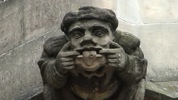So what does a contended and contentious music writer have to say about Shakespeare?
Well first off, he’s a damn fine scholar in my estimation. Second he’s got a bone to pick with another Lady scholar. And Clinton Heylin’s scholarship picks that bone like a starving hyena.
The premise is that the sonnet quarto published by Thomas Thorpe is a Bookleg: a bootleg copy of the sonnets as unauthorised as Bob Dylan’s Basement Tapes.
Absolutely, unequivocally, unauthorised by their author, W. Sh. that dedicated follower of fashion. Just as absolutely juxtaposed is the Lady Scholar, Katherine Duncan Jones position.
Her thesis in The Arden version of the Sonnets is that Thomas Thorpe actually was somewhat respected and wasn’t a bad penny after all. And Shakespeare trusted him to publish his revised sonnets, whilst he took care of a court case in Stratford about the six quid John Addenbrooke owed him, scornfully highlighted by Clinton.
Now I personally like the revision theory of the sonnets. And as KDJ points out in her introduction Drayton and Daniel both revised their work. And as we see from the manuscript versions of sonnets 2 and 8, and the 1599 published 138 and 144 variations do occur and the differences do look like revisited lines by their ever-loving poet.
I’ve always thought the fact that there was only one print run* of the Quarto of 1609 and some foofah about their existence and some talk of a dissatisfied author disallowing their further publication and retrieving the ones in print, was suspect.
The run would probably have been about 750 copies, tops was 1500 allowed for a print run. We just don’t know. We do know of the 13 extant copies of Q1609 Sonnets are the basis of all editor’s versions. What’s the chances of finding another to bring it to a most fitting number of 14?
*( until John Benson’s bastardised, bowdlerized version of 1640, which is a study in its own right, dealt with by Heylin in its own chapter).
Just like we know of 230 First Folios that are extant; of a more probable 1500 original print run. The difference being there are open leads on another 13 copies of the First Folio. But that’s another post.
Now the chain of events of how Sonnets in manuscript came to be Quarto in print remains unsolvable. Heylin takes dire exception to the Lady’s pat answer that plague forced Shakes to sell the revised manuscript to Thorpe via Ben Jonson.
Heylin sets out to prove they were pirated with excellent discussions of John Davies, Richard Brome (Ben Jonson’s self-serving manservant and later playwright) and Thomas Thorpe and the shady world of playwrights, poets, publishers and printers of Jacobethan England.
More importantly is the idea that Jacobethans loved to copy material down in manuscript. Their transmission then is outside the influence of the author and in the hands of scribal copyists like John Davies.
Who better placed to pilfer texts than they? Plus they appreciated the subject matter, had an affinity to it, perhaps even knew the author they were ripping off. Not that Thorpe ever really made any money off the sonnets.
This book is a no-nonsense take-no-prisoners look at the scholarship covering this most fought over ‘bookleg’ of sonnets. His focus leaps years from before they were published up to the present day. All the while delineating the battle lines of those who believe they were authorised and those who don’t.
The final chapter talks of a little red notebook in Bob Dylan’s handwriting, today housed in a library in NYC subject to Dylan office approval to be read. Yet, there is a bootleg version of said red book.
If only there were a little red book for these sonnets!
Praise goes to Clinton for not even deigning to mention the conspiracists. As for me I can’t help it. If Stratfordians had a series of letters written throughout his lifetime by me Shakespeare scholars would be kicking their heels and signing book contracts.
For example Oxfordians have such a collection of letters, claim their man is Shakespeare and yet use one or two slight references to the letters and ignore the rest. We’ve got handwriting D from Sir Thomas More. And yes Clinton deals with that too.

Leave a Reply
You must be logged in to post a comment.